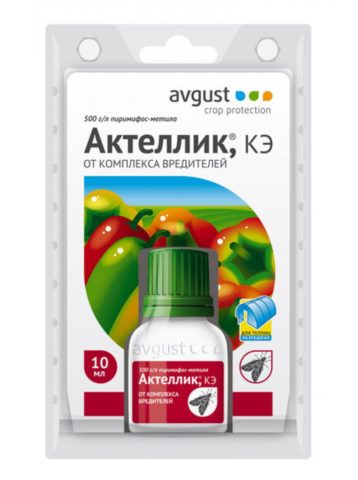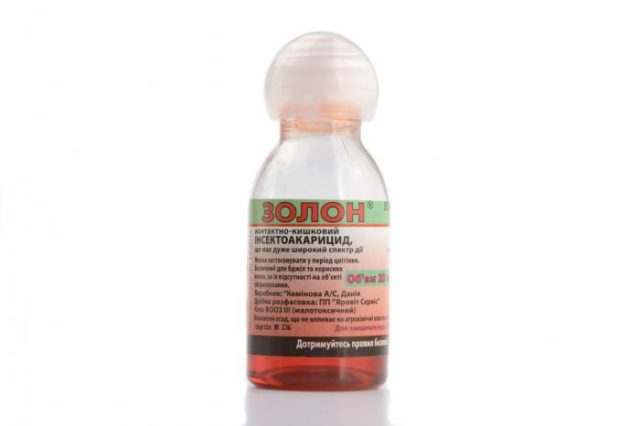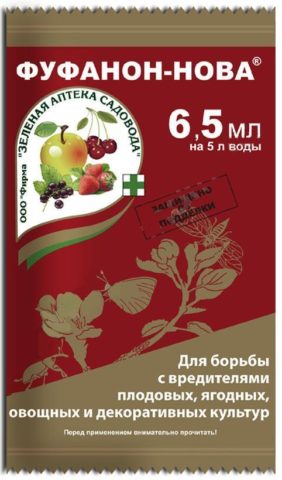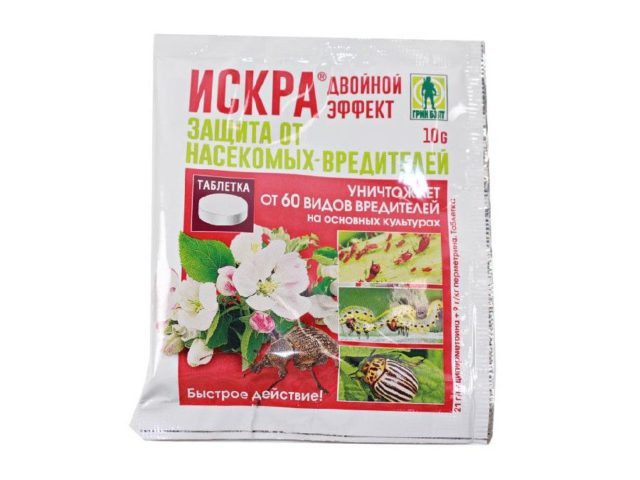Content
The cherry fly is one of the most "famous" pests of cherries and sweet cherries in Russian orchards. Apricot, honeysuckle, bird cherry and barberry also suffer from it. Its larvae develop in the berries of stone fruits, contaminate them with their excrement and feed on the pulp. They are able to quickly damage and destroy from half to 90% of the seasonal harvest - wormy fruits are deformed, fall off and rot, becoming unusable. Having identified this parasite, the gardener should not ignore the situation. The methods of dealing with cherry fly depend on the season, the mass of insect individuals and the degree of damage to trees. With this in mind, you can choose the most suitable method from proven folk recipes or use chemicals if the situation becomes critical. Fighting cherry fly, started on time and correctly, will help get rid of the parasite in the garden and preserve the harvest. And in order for the pest not to attack the trees again next season, it is imperative to take preventive measures.
Why are cherries wormy
The wormy fruits of cherries and sweet cherries are usually the result of the mass distribution of the cherry fly in the garden. Adult insects themselves practically do not harm the crop. But the small white larvae deposited by flies in the nutritious pulp of the berries is the main reason why cherries become wormy and quickly disappear.
It is possible to determine the activity of this pest even at the stage of fruit ripening. The place on the skin of the berry, which the cherry fly pierced in order to lay the egg, is at first clearly visible as a black dot. The pulp of the affected fruit, which the larva feeds on, decomposes under the influence of its excrement and begins to rot. Most of the wormy berries rapidly lose their shape and fall off, but even those that remain on the tree are still unsuitable for consumption.
However, if the owners of all bordering areas cooperate in this case, then it is quite possible to completely get rid of this parasite, or at least to minimize the damage it causes.
What does a cherry fly look like?
What an adult cherry fly looks like will allow you to present the photo below.
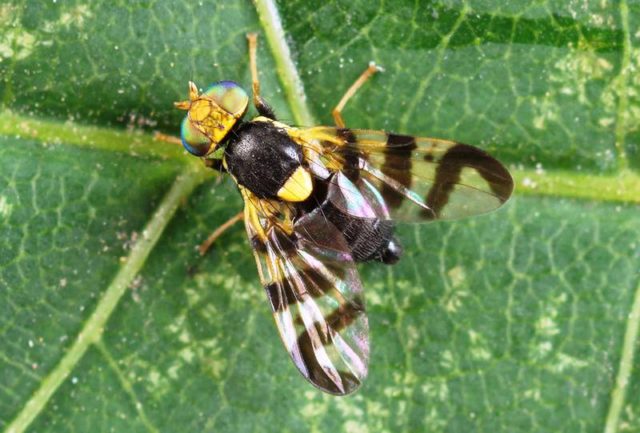
Cherry fly is a dangerous pest of many fruit and berry crops
It is a small winged insect 3-5 cm in length, resembling an ordinary housefly. Its body is glossy in appearance, it is dark brown or black in color. There are two long yellow stripes on the chest and abdomen.Front scutellum, tarsus and tibiae are dark yellow or pale orange in color. The shells of the faceted eyes of the cherry fly are bright green. The wings are wide and transparent with characteristic four dark transverse stripes on the surface.
Pest life cycle
Having familiarized yourself with the developmental stages of the cherry fly's body, it will be easier for the gardener to fight this pest. They can be briefly characterized as follows:
- Wintering. The cherry fly waits out the cold season in the form of a pupa, hidden in a false cocoon. Usually it deepens into the surface layer of soil under the crowns of trees by 5-7 cm.
- Departure. It begins after the soil warms up, roughly from mid-May, during the period when acacia begins to bloom. Adults (adults) emerge from pupae. At first, they are underdeveloped, they need additional nutrition. During the first couple of weeks after emergence, cherry flies are “eaten away” by the sweet secretions of aphids and juices that form in the cracks of leaves and fruits.
- Mating and reproduction. Occurs in sunny warm weather (18 degrees and above), usually in June and partly in July. The female cherry fly usually lays 1-2 eggs under the skin of ripening and already ripe fruits. Within a month, it is capable of producing from 80 to 150 eggs, after which it dies.
- Larva development. After 6-10 days, a tiny white worm (about 0.5 mm long) appears from the egg. Within 16-20 days spent in the berry, it grows up to 6-7 mm, actively feeding on the pulp. Then the larva leaves the wormy fruit, enters the soil and pupates.
- Pupation. After the larva passes and deepens into the ground, a pseudocoon is formed around it in a few hours. After 5-6 days, a pupa is formed in it. To successfully complete its development, the pupa needs low temperatures (less than 7 ° C), so the cherry fly hibernates in this form.
Then the cycle is repeated again.
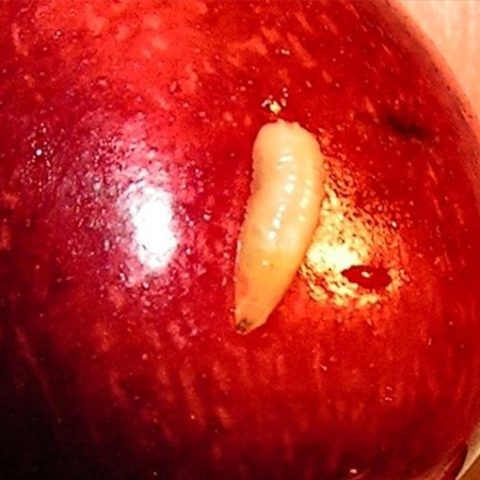
The larva of the pest feeds on the pulp of the berries and contaminates them with its excrement.
Causes and signs of appearance
Cherry fly years begin in late spring and last throughout June, sometimes extending into early July. It is most active on sunny and warm days.
It is possible to determine that a fruit tree has been attacked by this parasite by the following signs:
- on berries just beginning to ripen, black dots are clearly visible - traces of punctures in the skin by a female cherry fly that laid an egg;
- the presence on the surface of the fruit of depressions, decaying areas;
- the skin of a ripe wormy berry loses its glossy shine, darkens, and the pulp becomes soft to the touch;
- by cutting or breaking the fruit of a cherry or sweet cherry, inside (usually near the stone) you can find a small white larva.
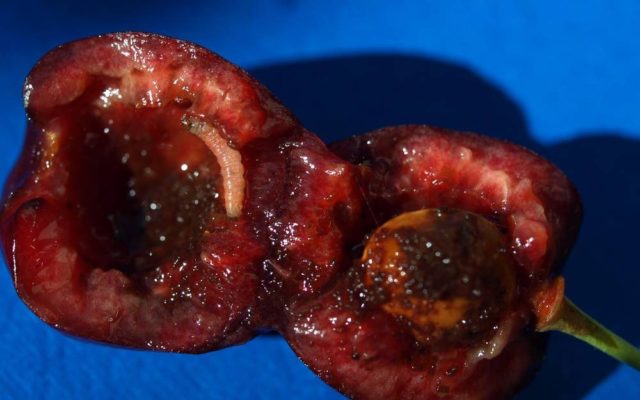
The flesh of the affected berries softens and rots, turning into gruel
Why is the appearance of a cherry fly in the garden dangerous?
In the event that, having found a cherry fly on the site, the farmer does not actively fight it, its number will increase from year to year, as will the damage to the crop. The larvae of this pest pupate and overwinter in the soil, and in the next season they attack trees in even greater numbers. The parasite is especially active in the southern regions, it may happen that up to 90% of the harvested berries turn out to be wormy.
How to deal with cherry fly
The sooner it was possible to find worms in cherries, the sooner you should try to get rid of the cause of their appearance. Every year, it is imperative to pay attention to preventive measures.If the cherry fly does appear, but its numbers are small, you can start by using folk remedies.
How to get rid of cherry flies with folk remedies
The advantage of folk methods of dealing with cherry fly is that they are gentle, harmless to humans, animals and the environment. However, their effectiveness is significantly lower than that of chemicals.
Among the proven folk recipes for this parasite are:
- Coniferous broth. To prepare it, you need to put a spruce or pine branch in a saucepan with cold water, bring to a boil and cool. After that, you can spray the trees with decoction. Repeat the treatment after heavy rain.
- Wood ash solution. It helps well against adults and larvae of the pest, and is also destructive for aphids, the secretions of which feed on the imago of cherry flies. Stir 1 shovel of ash in a bucket of boiling water and boil for 20 minutes. Then strain the broth, add water to a volume of 10 liters and use for processing crowns.
- For effective control of cherry fly, it is also advised to spray the affected trees with tobacco and soap infusion. It is prepared from 400 g of tobacco, which is poured into 10 liters of cold water and left for a day. After settling, the agent is boiled for an hour. Immediately before use, 40 g of grated laundry soap is added to the composition.
- The cherry fly smells extremely well, therefore, in the fight against it, infusions and decoctions with a sharp strong aroma are effective, frightening and disorienting adults. You can use onion peels, minced garlic cloves, nightshade and wormwood. Prepare funds in the same way as tobacco-soap infusion, only replace the main component.
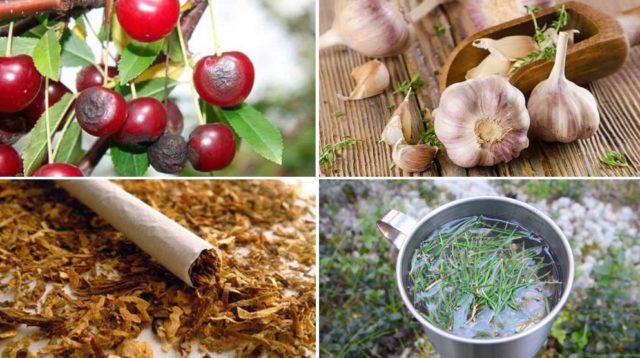
Folk remedies help if there are few pests and the lesions are insignificant.
Applying cherry fly traps
Homemade traps installed in the garden will help to fight the cherry fly, preventing the cherry from becoming wormy. They are of two types:
- Sweet bait traps. They can be made from halves of plastic bottles or empty cans. Pour compote, juice, beer, kvass or sugar syrup inside and hang on the branches. To protect one tree, 4–5 such traps will be enough. Cherry flies, attracted by the scent, are trapped and killed. The grower should from time to time clear the traps of dead insects and pour in a new batch of bait. It is worth hanging them when the flowering of the trees is over.
- Glue traps. They are made from cut sheets of cardboard that are bright yellow or red, which attracts cherry flies. A layer of special glue is applied on top of the sheets, which does not freeze in air for a long time, and traps are carefully placed along the periphery of the tree crown. Usually they are hung during the flowering period of acacia, when adults of the cherry fly are actively looking for additional food.

An effective and simple remedy - glue and liquid traps
How to get rid of worms in cherries with chemicals
Modern science has developed a large list of cherry fly chemicals that are effective against adults and larvae. The most commonly used:
- Actellik (50%) - emulsion or powder for solution preparation. Low toxic to humans and domestic animals, but dangerous to bees and fish.
- "Calypso" in the form of a concentrate to be diluted with water. Non-toxic to humans, animals, fish and bees.
- "Karate Zeon" in the form of microcapsules.When used correctly, it is low-toxic to humans.
- Zolon (35%) - concentrated emulsion. It is not very toxic for humans, but highly toxic to bees and fish.
- "Fufanon-Nova" - water-based emulsion. It is necessary to work with this substance no more than 3 hours in a row, using gloves and a respirator.
- "Spark Double Effect" - tablet preparation. Does not harm people, pets, earthworms, bees and fish. It is used to combat 60 types of harmful insects, including cherry fly.
Cherry fly drug use table
The features of the use of chemicals that help fight cherry fly are most clearly presented in the form of a table:
Active substance | Name drug | Preparation of the solution | Application rate | Application features |
Pyrimiphos-methyl | Actellic | 2 ml for 2 liters of water | 2.5 l for 1 tree | At least 20 days must elapse between processing and picking berries. |
Tiacloprid | Calypso | 2 ml for 10 l of water | 100 m2 garden | Do not spray the garden on a hot day, 2 hours before or immediately after rain |
Lambda Cyhalothrin | Karate Zeon | 4 ml for 10 l of water | 100 m2 garden | Process before flowering |
Fozalon | Zolon | 2 ml for 5 l of water | 10 m2 garden | Spray in dry weather. Processing twice a season |
Malathion | Fufanon-Nova | 11.5 ml per 1.5 l of water | 2-5 l for 1 tree | Harvesting is possible 3 weeks after spraying the trees with the drug |
Cypermethrin, permethrin | Spark Dual Effect | 1 tablet for 10 liters of water | 10 l for 1-5 trees | Process during flowering |
The video contains useful information on controlling cherry flies and preventing wormy berries: https://youtu.be/54am8TpQ95c
Cherry fly control rules
Any measures to combat cherry fly - both folk and biochemical - must be taken competently. It is necessary to take into account the time of the year, the current and expected in the near future weather, the phase of the growing season of the plant, the stage of the life cycle of the pest, the degree of damage.
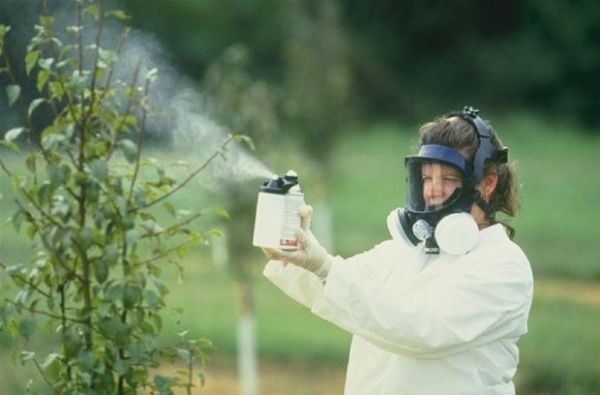
When working with chemicals, it is imperative to follow the instructions and adhere to the required safety measures
When can cherry fly cherries be processed?
Treating trees with insecticidal preparations is carried out if a cherry fly massively attacked the garden.
Sprinkle cherries twice:
- at the very beginning of summer, insects (during the flowering period of acacia);
- 10-14 days later, when the adults begin to lay eggs.
How to choose a cherry fly remedy depending on the lesion
As a rule, if the degree of damage to trees by a cherry fly is insignificant, gardeners prefer to use agrotechnical and folk remedies to combat this pest. If the threshold of harmfulness is exceeded (for every 100 cherries or sweet cherries there are 1-2 wormy berries), then they get rid of the parasite with the help of chemistry.
Trees of medium and late ripening periods are treated with insecticides. It is important that the day when the last spraying was carried out and the day of harvest is separated by at least 20 days - during this time, the toxic components of most drugs usually have time to decompose.
Security measures
Working with chemical insecticides should be extremely careful, not forgetting the main safety rules:
- when spraying the garden, it is necessary to protect the nose and mouth with a respirator, wear glasses on the eyes, and gloves on the hands;
- it is advisable to have special clothing designed only for working with chemicals, which after use must be ventilated and washed in a soap and soda solution;
- utensils that are used for the preparation and storage of drugs cannot be used for other purposes, as well as left in places accessible to children, next to food or animal feed;
- it is prohibited to eat, drink or smoke directly during the treatment of the site;
- at the end of the procedures, you need to thoroughly wash your hands with soap and rinse your mouth;
- do not allow children, pregnant and lactating women to work with insecticides.
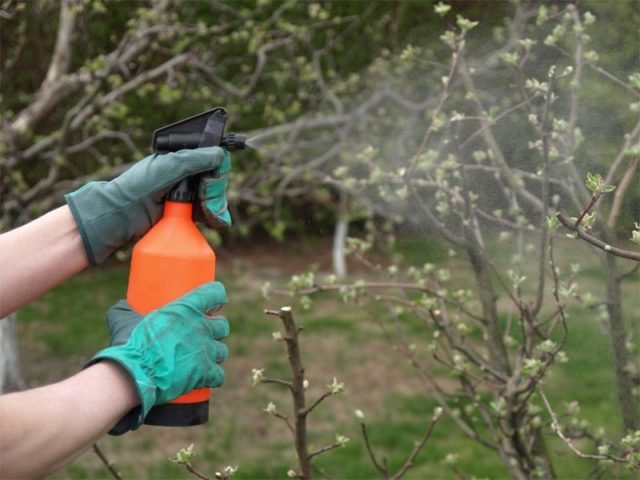
When choosing a drug, they are guided by the threshold of harmfulness of the cherry fly (1-2 spoiled berries per 100 pieces)
Cherry sprinkle from cherry fly
Spraying the crowns of fruit trees with tinctures and decoctions prepared according to folk recipes, or with insecticidal preparations is one of the key measures to combat cherry fly in spring. Here are some tips to help you complete this procedure correctly and safely:
- trees should be treated with a spray bottle in dry, calm weather, preferably in the evening or early morning;
- when spraying the crown, one should take into account the strength and direction of the wind, make sure that the spray of the agent used does not fall on people, animals and crops growing nearby;
- it is necessary to process not only the branches of "wormy" trees, but also the soil in the near-trunk circles;
- using a chemical preparation, it is imperative to observe the time specified in the instructions, which must elapse from the last spraying to harvest.
Features of processing during the fruiting period
It must be remembered that fruits from a tree previously treated with any preparations must be thoroughly washed before eating.
If the time for re-treatment with chemicals is missed, since harvest time is approaching, you can use biological products for spraying ("Akarin" or "Fitoverm"). The waiting time after using them is shorter.
Harvesting is required in full and as quickly as possible, without dividing the procedure into several stages. Worm cherries should never be left on the tree next to healthy ones. Having recognized those, it is imperative to collect and destroy them.
What to do with berries if cherries are wormy
An active fight against a cherry fly, seen in large quantities on the site, does not exclude the possibility that the cherry may already be wormy.
Soft, wrinkled and tarnished fruits, of course, are unsuitable for food - they should only be destroyed. However, if there are few wormy berries in the total mass, they are still strong, dense and poured in appearance, and at first glance do not differ from healthy ones, then you can try to get rid of the larvae. To do this, pour 1 kg of cherries or cherries with cool water with table salt (2 tsp for 2 liters) and let stand for half an hour. Then the floating worms are removed, and the berries are washed.
Fallen wormy fruits must be destroyed, in no case left in the near-trunk circles under the trees. It is advisable to collect and burn them, in extreme cases - to keep them in a container filled with water, and then bury them in the ground at a great distance from the orchard. In this case, the depth of the pit should be at least 0.5 m.
It is impossible to bury wormy berries directly on the site, since cherry flies have every chance of overwintering in the soil and will begin to harm again next year.
Cherry fly preventive measures
Fighting a cherry fly is a very difficult and time-consuming task. It is best to take care of the protection of shrubs and trees subject to its attacks in advance in order to prevent the appearance of wormy fruits.
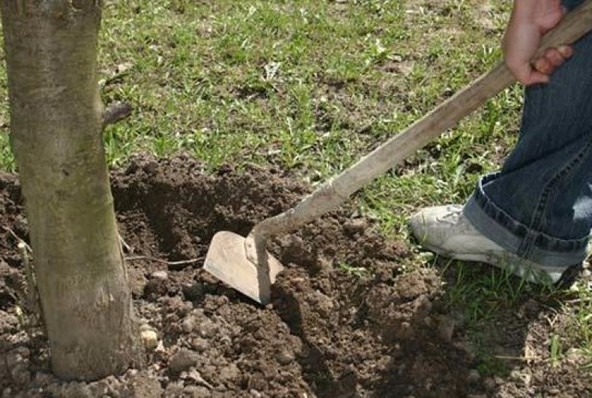
An effective preventive measure is digging the trunks three times a year
Cherry fly preventive measures include:
- thorough digging and loosening of soil in near-trunk circles to a depth of 25-30 cm three times a year - in early spring, summer and autumn;
- planting marigolds, marigolds, lemon balm under berry trees - plants that help fight cherry aphids, which provide food for adult flies;
- quick and careful collection of ripe berries, regular destruction of volunteers and fallen leaves;
- covering the ground under trees with film or agrofibre during the period of emergence of adult flies and pupation of larvae;
- fight against other parasites and diseases of berry trees.
Conclusion
Methods of dealing with cherry fly - a very common and dangerous pest of stone fruit crops - must be selected depending on many factors. If there are few insects and the lesions are insignificant, homemade traps and treating trees with folk remedies that are safe for humans and animals may be effective. However, in the case when the infestation of the cherry fly is massive, only complex measures to protect the garden can help, including agrotechnical measures and spraying with potent insecticides. It is very important to follow the safety rules when working with chemicals. Prevention of cherry fly damage to fruit and berry crops will help prevent the spread of the pest and save the crop.
